实例介绍
【实例简介】Automotive Power Systems
【实例截图】
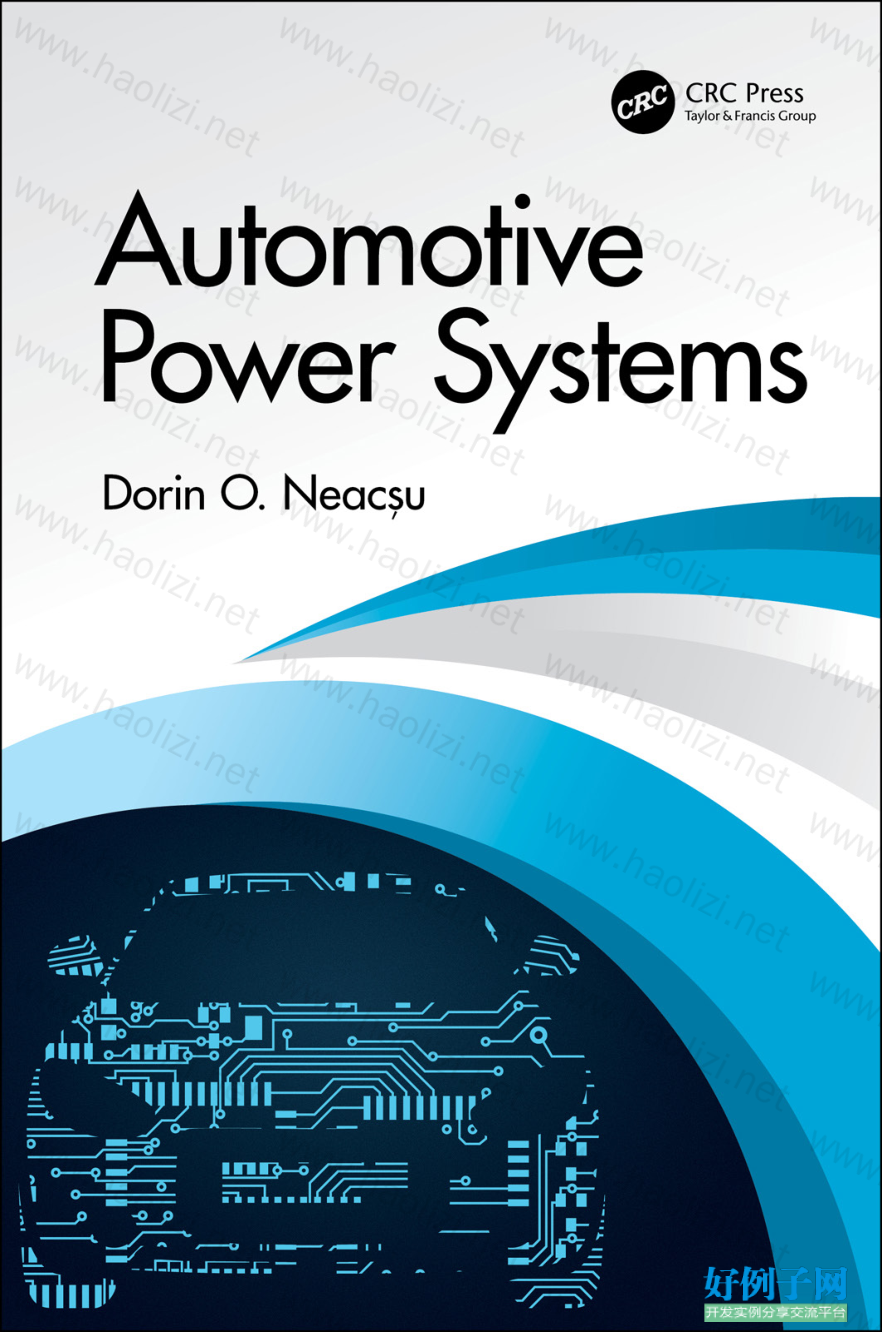



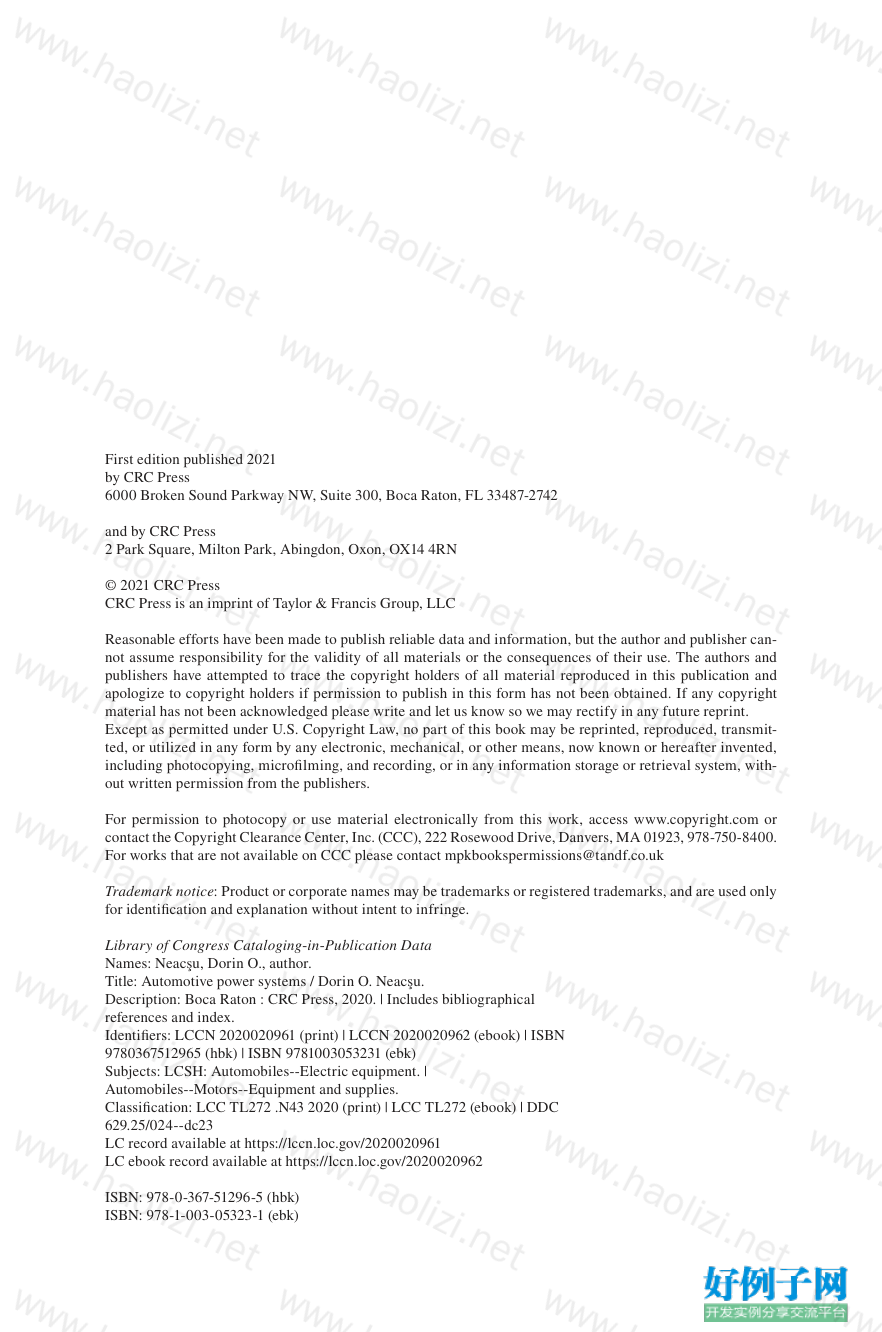
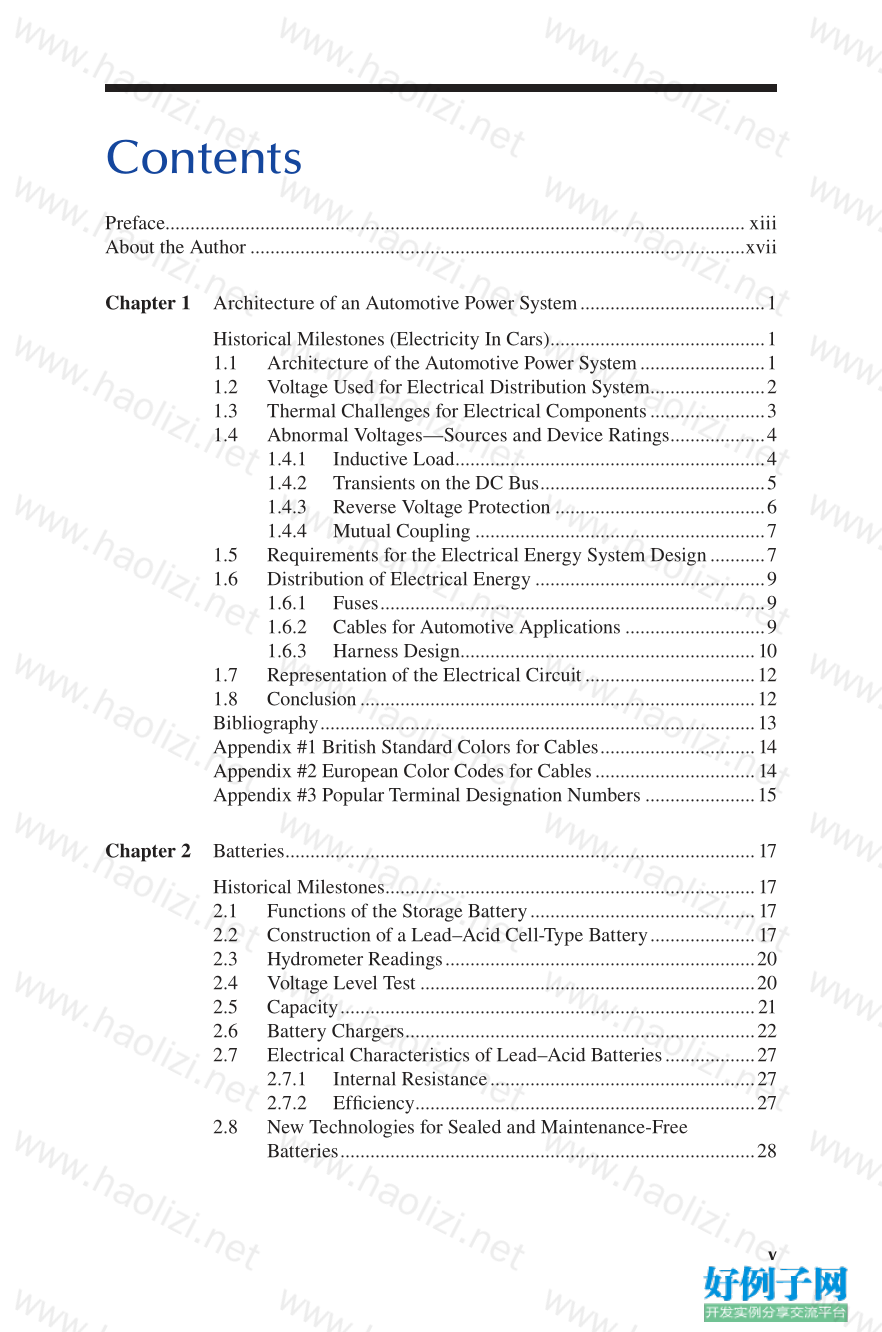
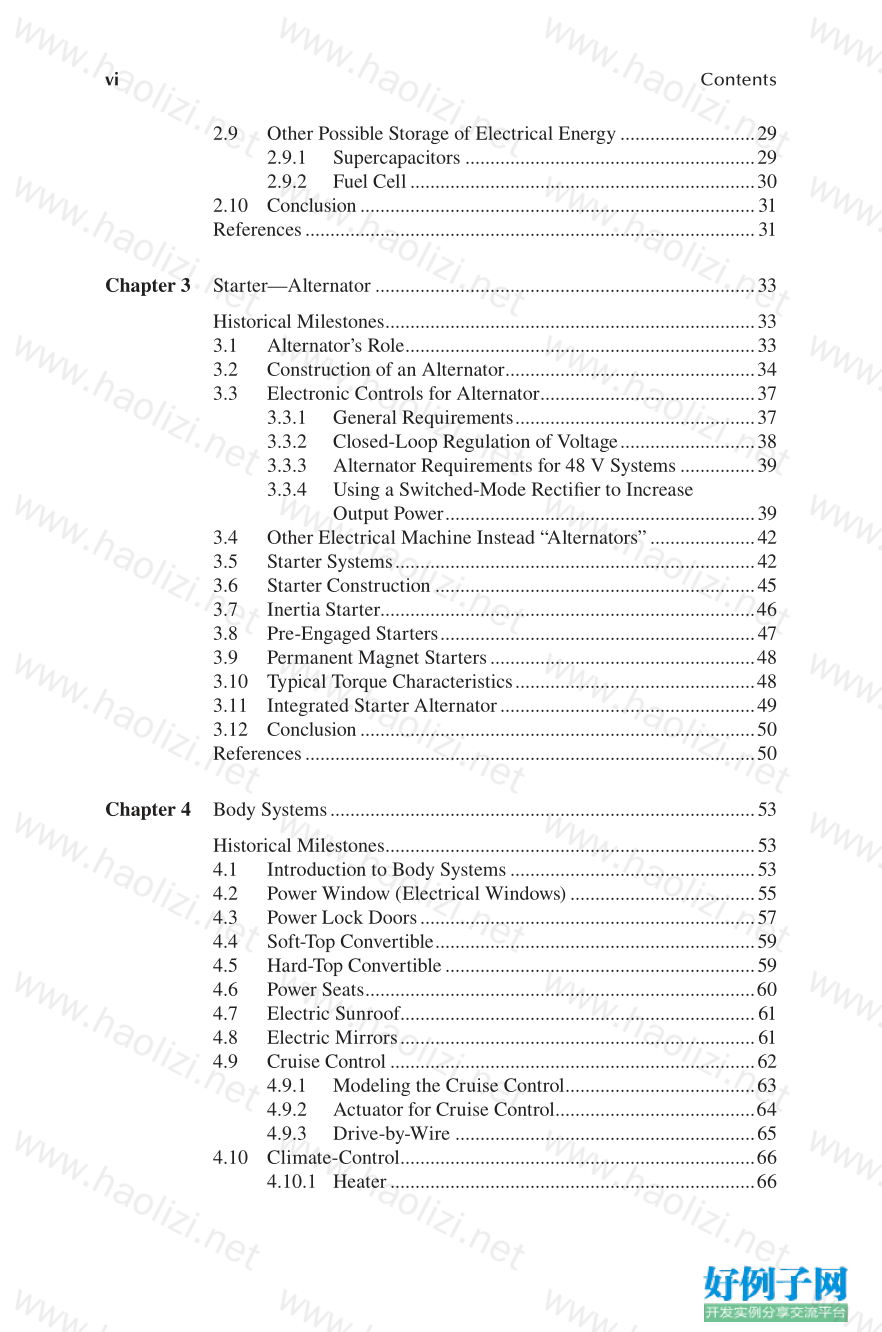
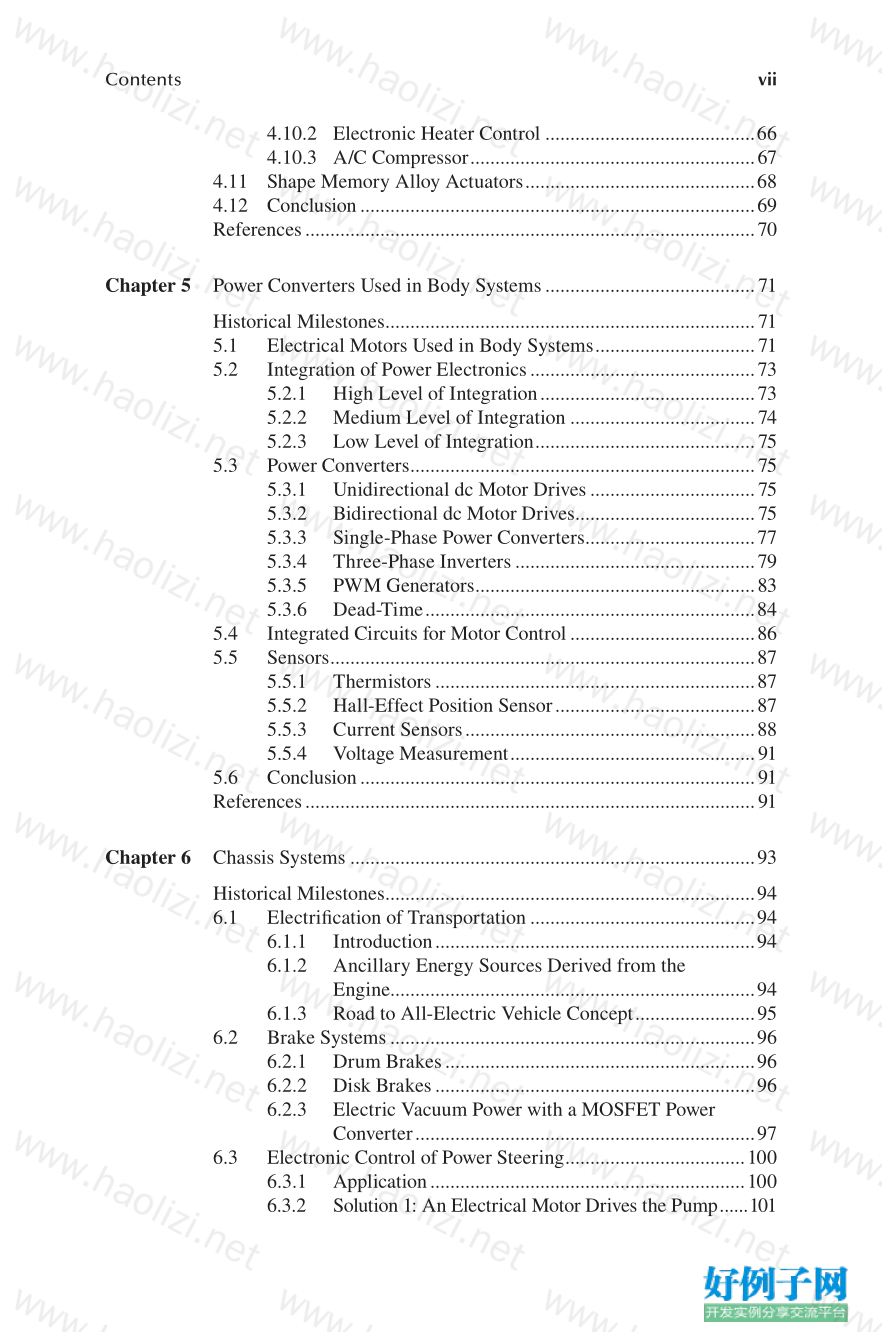
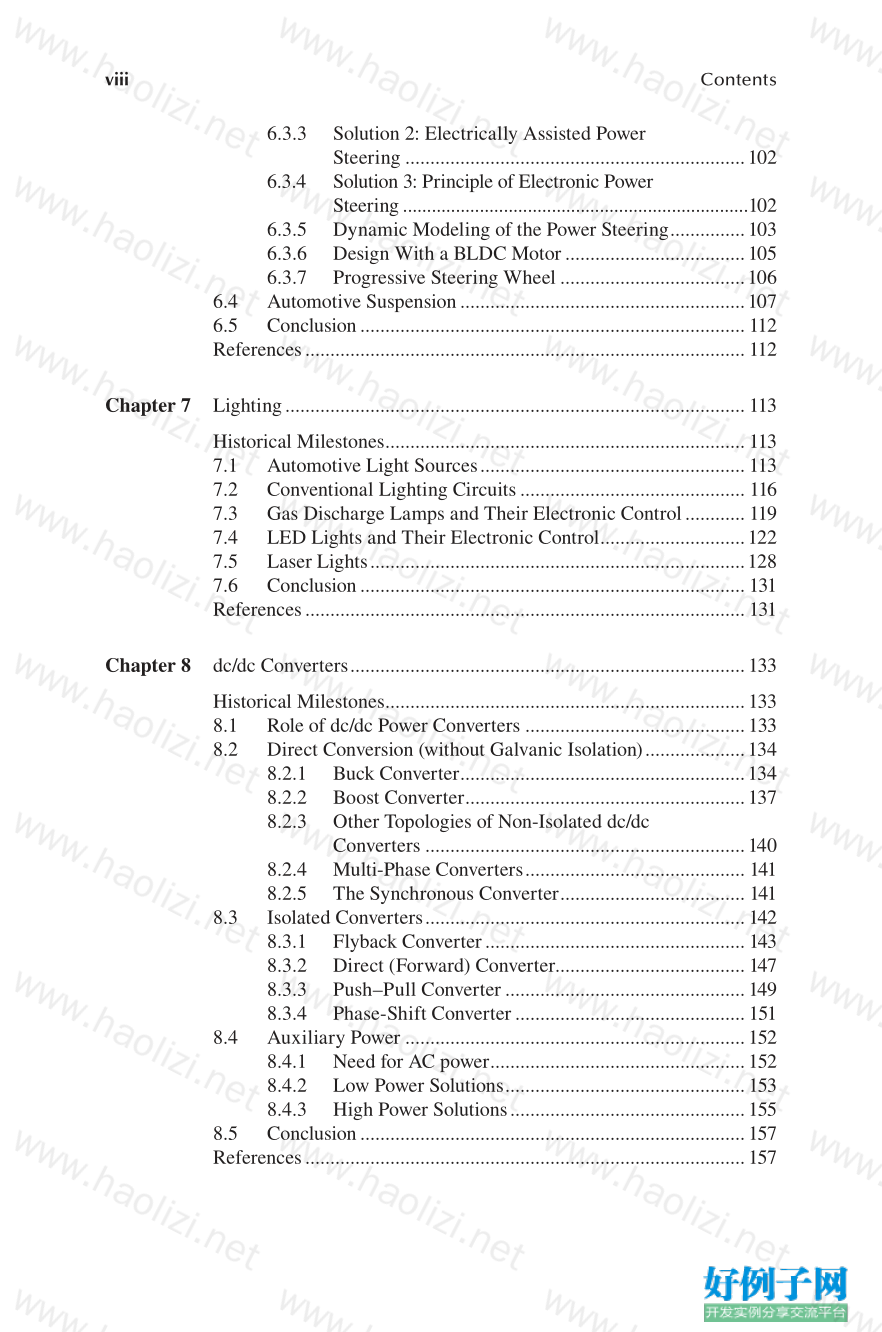
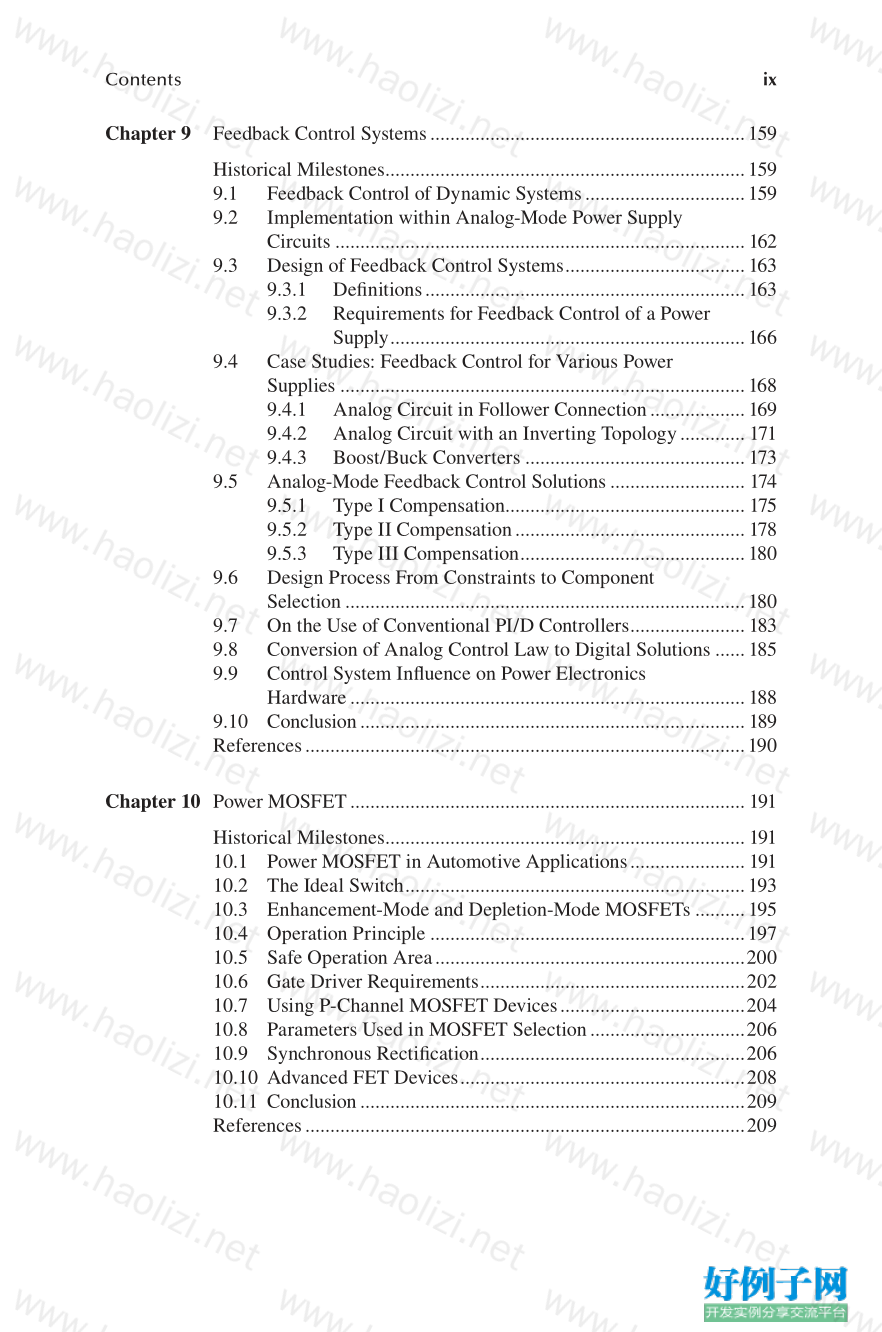


【核心代码】
The book fills a gap between books targeting practical education and works sharing advanced academic vision, offering students and academics a quick tour of the basic tools and long-standing infrastructure, and offering practicing engineers an introducti
Contents
Preface.................................................................................................................... xiii
About the Author ...................................................................................................xvii
Chapter 1 Architecture of an Automotive Power System.....................................1
Historical Milestones (Electricity In Cars)...........................................1
1.1 Architecture of the Automotive Power System.........................1
1.2 Voltage Used for Electrical Distribution System.......................2
1.3 Thermal Challenges for Electrical Components.......................3
1.4 Abnormal Voltages—Sources and Device Ratings...................4
1.4.1 Inductive Load..............................................................4
1.4.2 Transients on the DC Bus.............................................5
1.4.3 Reverse Voltage Protection ..........................................6
1.4.4 Mutual Coupling ..........................................................7
1.5 Requirements for the Electrical Energy System Design...........7
1.6 Distribution of Electrical Energy ..............................................9
1.6.1 Fuses.............................................................................9
1.6.2 Cables for Automotive Applications ............................9
1.6.3 Harness Design........................................................... 10
1.7 Representation of the Electrical Circuit..................................12
1.8 Conclusion...............................................................................12
Bibliography....................................................................................... 13
Appendix #1 British Standard Colors for Cables...............................14
Appendix #2 European Color Codes for Cables ................................ 14
Appendix #3 Popular Terminal Designation Numbers ...................... 15
Chapter 2 Batteries.............................................................................................. 17
Historical Milestones.......................................................................... 17
2.1 Functions of the Storage Battery ............................................. 17
2.2 Construction of a Lead–Acid Cell-Type Battery.....................17
2.3 Hydrometer Readings..............................................................20
2.4 Voltage Level Test ...................................................................20
2.5 Capacity...................................................................................21
2.6 Battery Chargers......................................................................22
2.7 Electrical Characteristics of Lead–Acid Batteries..................27
2.7.1 Internal Resistance.....................................................27
2.7.2 Effjciency....................................................................27
2.8 New Technologies for Sealed and Maintenance-Free
Batteries ...................................................................................28
vi Contents
2.9 Other Possible Storage of Electrical Energy...........................29
2.9.1 Supercapacitors ..........................................................29
2.9.2 Fuel Cell.....................................................................30
2.10 Conclusion ............................................................................... 31
References .......................................................................................... 31
Chapter 3 Starter—Alternator ............................................................................ 33
Historical Milestones.......................................................................... 33
3.1 Alternator’s Role...................................................................... 33
3.2 Construction of an Alternator..................................................34
3.3 Electronic Controls for Alternator...........................................37
3.3.1 General Requirements................................................37
3.3.2 Closed-Loop Regulation of Voltage...........................38
3.3.3 Alternator Requirements for 48 V Systems ...............39
3.3.4 Using a Switched-Mode Rectifjer to Increase
Output Power ..............................................................39
3.4 Other Electrical Machine Instead “Alternators”.....................42
3.5 Starter Systems........................................................................42
3.6 Starter Construction ................................................................45
3.7 Inertia Starter...........................................................................46
3.8 Pre-Engaged Starters...............................................................47
3.9 Permanent Magnet Starters.....................................................48
3.10 Typical Torque Characteristics................................................48
3.11 Integrated Starter Alternator...................................................49
3.12 Conclusion...............................................................................50
References ..........................................................................................50
Chapter 4 Body Systems ..................................................................................... 53
Historical Milestones.......................................................................... 53
4.1 Introduction to Body Systems ................................................. 53
4.2 Power Window (Electrical Windows) ..................................... 55
4.3 Power Lock Doors ................................................................... 57
4.4 Soft-Top Convertible................................................................59
4.5 Hard-Top Convertible..............................................................59
4.6 Power Seats..............................................................................60
4.7 Electric Sunroof....................................................................... 61
4.8 Electric Mirrors.......................................................................61
4.9 Cruise Control .........................................................................62
4.9.1 Modeling the Cruise Control......................................63
4.9.2 Actuator for Cruise Control........................................64
4.9.3 Drive-by-Wire ............................................................65
4.10 Climate-Control.......................................................................66
4.10.1 Heater.........................................................................66
vii Contents
4.10.2 Electronic Heater Control ..........................................66
4.10.3 A/C Compressor.........................................................67
4.11 Shape Memory Alloy Actuators..............................................68
4.12 Conclusion...............................................................................69
References ..........................................................................................70
Chapter 5 Power Converters Used in Body Systems .......................................... 71
Historical Milestones.......................................................................... 71
5.1 Electrical Motors Used in Body Systems................................71
5.2 Integration of Power Electronics.............................................73
5.2.1 High Level of Integration...........................................73
5.2.2 Medium Level of Integration ..................................... 74
5.2.3 Low Level of Integration............................................ 75
5.3 Power Converters..................................................................... 75
5.3.1 Unidirectional dc Motor Drives ................................. 75
5.3.2 Bidirectional dc Motor Drives.................................... 75
5.3.3 Single-Phase Power Converters..................................77
5.3.4 Three-Phase Inverters ................................................79
5.3.5 PWM Generators........................................................83
5.3.6 Dead-Time..................................................................84
5.4 Integrated Circuits for Motor Control .....................................86
5.5 Sensors.....................................................................................87
5.5.1 Thermistors ................................................................87
5.5.2 Hall-Effect Position Sensor........................................87
5.5.3 Current Sensors..........................................................88
5.5.4 Voltage Measurement.................................................91
5.6 Conclusion ............................................................................... 91
References .......................................................................................... 91
Chapter 6 Chassis Systems .................................................................................93
Historical Milestones..........................................................................94
6.1 Electrifjcation of Transportation .............................................94
6.1.1 Introduction................................................................94
6.1.2 Ancillary Energy Sources Derived from the
Engine.........................................................................94
6.1.3 Road to All-Electric Vehicle Concept........................95
6.2 Brake Systems .........................................................................96
6.2.1 Drum Brakes..............................................................96
6.2.2 Disk Brakes................................................................96
6.2.3 Electric Vacuum Power with a MOSFET Power
Converter ....................................................................97
6.3 Electronic Control of Power Steering....................................100
6.3.1 Application...............................................................100
6.3.2 Solution 1: An Electrical Motor Drives the Pump......101
viii Contents
6.3.3 Solution 2: Electrically Assisted Power
Steering .................................................................... 102
6.3.4 Solution 3: Principle of Electronic Power
Steering ........................................................................102
6.3.5 Dynamic Modeling of the Power Steering...............103
6.3.6 Design With a BLDC Motor .................................... 105
6.3.7 Progressive Steering Wheel ..................................... 106
6.4 Automotive Suspension ......................................................... 107
6.5 Conclusion ............................................................................. 112
References ........................................................................................ 112
Chapter 7 Lighting ............................................................................................ 113
Historical Milestones........................................................................ 113
7.1 Automotive Light Sources..................................................... 113
7.2 Conventional Lighting Circuits ............................................. 116
7.3 Gas Discharge Lamps and Their Electronic Control ............ 119
7.4 LED Lights and Their Electronic Control............................. 122
7.5 Laser Lights...........................................................................128
7.6 Conclusion ............................................................................. 131
References ........................................................................................ 131
Chapter 8 dc/dc Converters...............................................................................133
Historical Milestones........................................................................ 133
8.1 Role of dc/dc Power Converters ............................................ 133
8.2 Direct Conversion (without Galvanic Isolation)....................134
8.2.1 Buck Converter......................................................... 134
8.2.2 Boost Converter........................................................ 137
8.2.3 Other Topologies of Non-Isolated dc/dc
Converters ................................................................ 140
8.2.4 Multi-Phase Converters............................................ 141
8.2.5 The Synchronous Converter..................................... 141
8.3 Isolated Converters................................................................ 142
8.3.1 Flyback Converter .................................................... 143
8.3.2 Direct (Forward) Converter...................................... 147
8.3.3 Push–Pull Converter ................................................ 149
8.3.4 Phase-Shift Converter .............................................. 151
8.4 Auxiliary Power .................................................................... 152
8.4.1 Need for AC power................................................... 152
8.4.2 Low Power Solutions................................................ 153
8.4.3 High Power Solutions...............................................155
8.5 Conclusion ............................................................................. 157
References ........................................................................................ 157
ix Contents
Chapter 9 Feedback Control Systems ............................................................... 159
Historical Milestones........................................................................ 159
9.1 Feedback Control of Dynamic Systems ................................ 159
9.2 Implementation within Analog-Mode Power Supply
Circuits .................................................................................. 162
9.3 Design of Feedback Control Systems.................................... 163
9.3.1 Defjnitions ................................................................ 163
9.3.2 Requirements for Feedback Control of a Power
Supply ....................................................................... 166
9.4 Case Studies: Feedback Control for Various Power
Supplies ................................................................................. 168
9.4.1 Analog Circuit in Follower Connection ................... 169
9.4.2 Analog Circuit with an Inverting Topology ............. 171
9.4.3 Boost/Buck Converters ............................................ 173
9.5 Analog-Mode Feedback Control Solutions ........................... 174
9.5.1 Type I Compensation................................................ 175
9.5.2 Type II Compensation .............................................. 178
9.5.3 Type III Compensation............................................. 180
9.6 Design Process From Constraints to Component
Selection ................................................................................ 180
9.7 On the Use of Conventional PI/D Controllers....................... 183
9.8 Conversion of Analog Control Law to Digital Solutions ...... 185
9.9 Control System Infmuence on Power Electronics
Hardware ............................................................................... 188
9.10 Conclusion ............................................................................. 189
References ........................................................................................ 190
Chapter 10 Power MOSFET ............................................................................... 191
Historical Milestones........................................................................ 191
10.1 Power MOSFET in Automotive Applications ....................... 191
10.2 The Ideal Switch....................................................................193
10.3 Enhancement-Mode and Depletion-Mode MOSFETs .......... 195
10.4 Operation Principle ............................................................... 197
10.5 Safe Operation Area..............................................................200
10.6 Gate Driver Requirements.....................................................202
10.7 Using P-Channel MOSFET Devices.....................................204
10.8 Parameters Used in MOSFET Selection...............................206
10.9 Synchronous Rectifjcation.....................................................206
10.10 Advanced FET Devices.........................................................208
10.11 Conclusion.............................................................................209
References ........................................................................................209
x Contents
Chapter 11 Fuses and Relay Circuits .................................................................. 211
Historical Milestones........................................................................ 211
11.1 Intelligent Switch Versus Solid-State Relay.......................... 211
11.2 Electromagnetic Relays ......................................................... 212
11.2.1 Using Electromagnetic Relays.................................. 212
11.2.2 Construction ............................................................. 214
11.3 Solid-State Relays.................................................................. 216
11.4 Introduction to Fuses............................................................. 219
11.5 Circuit Breakers.....................................................................223
11.6 Automotive Varistor and Transient-Voltage-
Suppression (TVS) .................................................................223
11.7 Solenoids................................................................................225
11.7.1 Electromechanical Solenoid.....................................225
11.7.2 Solenoid Valve..........................................................226
11.7.3 Power Converter Drive.............................................228
11.8 Conclusion.............................................................................228
References ........................................................................................228
Chapter 12 Small Motors....................................................................................231
Historical Milestones........................................................................ 231
12.1 Principle of Electrical Motors ............................................... 231
12.1.1 Permanent Magnet Motors.......................................231
12.1.2 Variable Reluctance Motor....................................... 232
12.1.3 DC Motors................................................................234
12.1.4 Induction Motor........................................................ 235
12.1.5 Brushless Motors......................................................236
12.1.6 Comparison between Brushless dc Motor and the
Induction Motor ........................................................240
12.2 Design of Low-Power dc Motors...........................................242
12.2.1 Shunt-Wound dc Motors...........................................242
12.2.2 Series-Wound dc Motors..........................................243
12.2.3 Compound Wound dc Motor....................................243
12.2.4 Permanent Magnet dc Motors ..................................244
12.3 Applications: Fans, Blowers, Pumps.....................................245
12.4 Design Issues Related to the dc Distribution Bus..................247
12.5 Motor Design: Inertia Matching............................................248
12.6 Motor Design: Torque Requirements ....................................249
12.7 Ultrasonic Motors (Piezoelectric Motors).............................251
12.7.1 Principle ................................................................... 251
12.7.2 Control and Optimization ........................................ 253
12.8 Conclusion.............................................................................254
References ........................................................................................254
xi Contents
Chapter 13 Power Integrated Circuits.................................................................255
Historical Milestones........................................................................ 255
13.1 Integrated-Circuit Technologies............................................256
13.2 Architecture of Analog or Mixed-Mode Power IC ............... 257
13.2.1 Example of Disruptive Innovation—PWM
Control Chip .............................................................257
13.2.2 Flyback PWM Controller IC for Isolated Power
Supplies ....................................................................259
13.2.3 Three-Phase Power MOSFET Controller ................260
13.2.4 High-Voltage Gate Drivers for High-Voltage
Propulsion Drives .....................................................260
13.3 IC Design Considerations......................................................262
13.3.1 Power MOSFET Used within Integrated
Circuits ..................................................................... 262
13.3.2 Power Diode.............................................................264
13.3.3 Gate Driver...............................................................265
13.3.4 Band Gap Reference.................................................266
13.3.5 PWM Generator.......................................................266
13.3.6 Current Sensor..........................................................266
13.3.7 Auxiliary Protection Circuitry.................................268
13.3.8 Soft-Start Circuitry...................................................269
13.3.9 I/O Connections .......................................................269
13.4 Digital IC Solutions ............................................................... 270
13.5 Conclusion ............................................................................. 270
References ........................................................................................ 271
Chapter 14 Propulsion Systems .......................................................................... 273
Historical Milestones........................................................................ 273
14.1 Propulsion Architecture ........................................................ 273
14.2 Induction Motor Drive—Converter System..........................276
14.3 Brushless dc Motor Drive......................................................283
14.4 Switched Reluctance Motor Drive.........................................285
14.5 High-Voltage Energy Storage................................................288
14.6 Conclusion.............................................................................289
References ........................................................................................290
Index...................................................................................................................... 291
标签: system STEM sys em TI Automotive Power Systems
小贴士
感谢您为本站写下的评论,您的评论对其它用户来说具有重要的参考价值,所以请认真填写。
- 类似“顶”、“沙发”之类没有营养的文字,对勤劳贡献的楼主来说是令人沮丧的反馈信息。
- 相信您也不想看到一排文字/表情墙,所以请不要反馈意义不大的重复字符,也请尽量不要纯表情的回复。
- 提问之前请再仔细看一遍楼主的说明,或许是您遗漏了。
- 请勿到处挖坑绊人、招贴广告。既占空间让人厌烦,又没人会搭理,于人于己都无利。
关于好例子网
本站旨在为广大IT学习爱好者提供一个非营利性互相学习交流分享平台。本站所有资源都可以被免费获取学习研究。本站资源来自网友分享,对搜索内容的合法性不具有预见性、识别性、控制性,仅供学习研究,请务必在下载后24小时内给予删除,不得用于其他任何用途,否则后果自负。基于互联网的特殊性,平台无法对用户传输的作品、信息、内容的权属或合法性、安全性、合规性、真实性、科学性、完整权、有效性等进行实质审查;无论平台是否已进行审查,用户均应自行承担因其传输的作品、信息、内容而可能或已经产生的侵权或权属纠纷等法律责任。本站所有资源不代表本站的观点或立场,基于网友分享,根据中国法律《信息网络传播权保护条例》第二十二与二十三条之规定,若资源存在侵权或相关问题请联系本站客服人员,点此联系我们。关于更多版权及免责申明参见 版权及免责申明



网友评论
我要评论